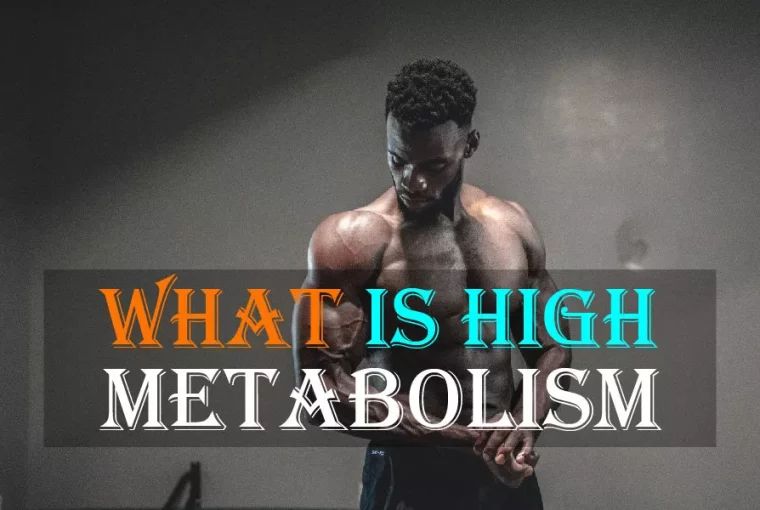Our bodies differ immensely from those of simple organisms. We experience an incredible mix of bodily processes that many organisms don’t.
Several chemical processes take place within the bodies of complex organisms. The umbrella term for all these processes is metabolism.
Metabolic rates differ between individuals. These involuntary processes are critical to our survival.
Genetics and inheritance are the key determinants of our metabolic rates. You cannot permanently alter your metabolic rate, as it is innate and unchangeable.
Simple organisms experience minor metabolic activities. Simple processes such as excretion occur through osmosis and diffusion.
Metabolism is a necessity for human health. Irregular metabolic activities can cause conditions like prostatic hyperplasia. Click here to find out how to protect yourself.
What is high metabolism?
High metabolism refers to rapid chemical activity in the body. It can be in respiration, enzymic reactions that facilitate digestion, transportation of substances, etc. When these processes occur quickly within the body, it is called high metabolism.
Metabolism And Weight Loss
Metabolism is a crucial aspect of weight loss. The metabolic rate of each individual is unique.
Metabolic functions include breathing, excretion, thermoregulation, and even digestion.
Metabolic processes occur regularly. You cannot alter the underlying metabolic rates of individuals.
While some activities might temporarily increase metabolism, the underlying rate is determined by genetics and trait inheritance.
The respiration rate is substantially slower in those who have a sluggish metabolism. Because they do not utilize the calories and fat in their bodies effectively, they are more likely to be overweight and obese.
Examples Of Metabolic Processes
Several processes take place in the human body. The metabolic processes are chemical-based. These processes vary immensely.
They include:
Thermoregulation functions
Just like other mammals and birds, human beings are a homoiothermic species. It means that they can regulate their body temperature and that their core temperature is not relative to that of the environment.
To archive a homoiothermic state, human beings have internal controls called thermoregulation. Thermoregulation is a metabolic function that primarily occurs in three main ways. They are:
- The central control
- Afferent controls
- Efferent controls
The hypothalamus initiates the thermoregulation process after receiving sensory inputs from the skin. Depending on how the signal is interpreted, there are two possible responses:
Heating
When the body temperature is low, respiration occurs faster. Respiration occurs faster, and the body uses insulin to digest basic monosaccharides for the cells to use in energy production. Consequently, body temperature rises due to faster respiration.
Cooling
Then the body temperature is too high, respiration decreases. The body secretes less insulin, and energy production declines. It causes a cooling effect on the body.
Excretion
Excretion is the process through which the body eliminates toxic substances. Human beings produce natural toxins due to chemical reactions in the body.
We can eliminate toxins that would otherwise have accumulated and poisoned the body thanks to metabolism.
Excretion occurs on several organs. They include our lungs, kidneys, and skin.
Our lungs eliminate carbon (IV) oxide from the body. Our bodies produce gas as a byproduct of respiration. Excess accumulation of carbon (IV) oxide causes suffocation and ultimately death.
Excess carbon (IV) oxide is transported in the blood as carboxyhemoglobin, dissociating in the lungs as a gas, exhaling it.
Our kidneys eliminate nitrogenous waste such as ammonia. The process is known as ultrafiltration. Ultrafiltration occurs in the nephrons, where nitrogenous waste is separated from the blood.
The waste is transported to the bladder through the ureter. Once the ureter is full, we get the urge to urinate. We pass out nitrogenous waste by contracting the sphincter muscles.
The skin excretes excess water and some salts as well. Too much water in the body creates an osmotic imbalance which is undesirable.
When it happens, the thalamus causes the pores to relax, and this causes water to escape as sweat.
Digestion
Digestion occurs due to enzymic activities within the body. The enzyme production is triggered through several metabolic processes.
Proteins are digested to peptides in the stomach by protease. Protease is secreted through metabolic activities.
Once proteins have been digested, the body secretes the relevant inhibitor to stem the production of proteases.
Salivary amylase digests glucose to basic monosaccharides that the body can utilize immediately in cell functions.
Lactase digests lactose in the duodenum. Through metabolic processes, lactase inhibitors are released to stem its production.
Sucrase digests sucrose in the duodenum. Its production and inhibition also occur through metabolic processes.
The same is the case with maltase, an enzyme that digests maltose to basic monosaccharides and simple sugars.
Other Homeostatic processes
Homeostasis is an umbrella term that covers all auto-regulatory processes that occur in the bodies of living organisms. Thermoregulation is a great example of a homeostatic process.
Osmoregulation is also a homeostatic process. It is vital to the process of excretion, particularly in simple single-cell organisms. It also plays a key role in eliminating excess water from our bodies.
Regulating blood glucose is a major homeostatic function. Excess sugar in the blood causes diabetes mellitus, and little blood sugar causes insipidus.
Metabolic Disorders
There are many types of ailments, some of which stem from metabolic irregularities in our bodies. Other non-metabolic disorders such as prostate cancer are preventable. Click here to find out more.
Metabolic disorders are mostly genetic, and there is nothing we can do to escape them fully. What are some common disorders?
1. Hurler syndrome
Anomalies in the bone structure characterize it. Lysosome storage disorder causes the disease. The patient experiences developmental delays during childhood. Other symptoms include cornea clouding, swollen tonsils, and hernias.
2. Fabry Disease
Fabry disease only affects males. It is also a metabolic disorder caused by lysosome storage anomalies. The symptoms include swollen limbs, deafness, symptoms persistent with flu, and dizziness.
3. Tay-Sachs disease
Tay-Sachs disease is a lethal metabolic disorder. Its patients succumb to the illness within five months. It affects the central nervous system.
4. Urea cycle disorders
It is a cluster of renal disorders that occurs because of metabolic disorders. Its symptoms are persistent to those of a stroke victim.
Other symptoms include constant fatigue, heightened irritability, protein allergies, and constant delirium.
5. Von Gierke disease
It is caused by an accumulation of glycogen in the liver. After some time, the patient will develop low blood sugar.
6. Andersen disease:
It is a severe disease that causes scarring in vital organs. It happens when the body cannot regulate glycogen levels, causing white blood cell deposits in vital organs. The condition leads to non-alcoholic liver cirrhosis.
7. Forbes disease:
Forbes disease results from a body’s inability to break down glycogen into simpler sugars. The body needs the sugar in cellular processes. It causes weakness in the muscles and constant fatigue due to stunted respiration.
8. Zellweger syndrome:
It is a metabolic disease that affects newborn children. The characteristics include deafness, blindness, poor muscle tone, microcephaly, and a slanted face.
Hypermetabolism Vs. High Metabolism
Hypermetabolism is a condition that is characterized by elevated metabolic levels. It is also known as Resting Energy Expenditure.
Hypermetabolism causes rapid caloric deficits in very short periods. As a result, the patient suffers from drastic weight loss. Just like other metabolic disorders, hypermetabolism is a hereditary condition.
The main symptoms of hypermetabolism are insomnia, muscle weakness, constant fatigue, low levels of iron in the blood, rapid and irregular heartbeat rates.
High metabolism is not a medical condition. It is normal and natural to some individuals. Metabolism occurs at a high rate but not to the point where it is dangerous to an individual’s health.
People with high metabolism are unlikely to suffer from conditions such as obesity. They are, however, likely to struggle to put on weight. High metabolism is perceived to be advantageous and desirable by many folks.
Catabolic Vs. Anabolic Metabolism
Several metabolic processes are essential to our survival. You can summarize all metabolic reactions into two distinct categories: catabolism and anabolism.
Catabolism encompasses all activities that break down complex structures into simpler structures.
An example of a catabolic reaction is when enzyme protease digests complex proteins into simple peptides. In catabolic reactions, energy is released.
Anabolism encompasses all activities that combine simple structures to form complex ones. An example is the formation of carboxyhemoglobin, where carbon (IV) oxide combines with hemoglobin in the red blood cells. In anabolic reactions, energy is required.
Conclusion
Metabolism is an umbrella term that describes all the chemical processes that occur within the body of a living organism. It is essential to the survival of species. Respiration enables our bodies to have energy, eliminate waste, assimilate nutrients, etc.
Metabolic rates differ from one person to the other. You cannot alter your metabolic rate permanently. It is pegged to your genetics and inheritance. A high metabolic rate has its advantages and disadvantages.
It would be best not to mistake high metabolism for hypermetabolism, as the latter is a medical condition.




